-
Car Reviews
- All reviews
- Midsize SUVs
- Small cars
- Utes
- Small SUVs
- Large SUVs
- Large cars
- Sports SUVs
- Sports cars
- Vans
Latest reviews
- Car News
-
Car Comparisons
Latest comparisons
- Chasing Deals
The old Ford Escape was a worthy SUV, but it didn’t sell well in Australia. This time, Ford is betting the the new fourth-generation Escape can out-manoeuvre key rivals.
Cutting through in the hard-fought midsize SUV segment in Australia is really tough. Buyers flock to big-name achievers like the Toyota RAV4, Mazda CX-5 and Volkswagen Tiguan while even the second tier of sellers in this class move thousands of cars onto Australian driveways each month.
Generally, the SUVs that sell well in Australia are worthy family cars, which is why the slow sales of the previous-generation Ford Escape were perplexing. In 2019, the Escape earned just two per cent of the market.
Which is why the new, fourth-gen 2021 Ford Escape has gone all out, with a new platform, a radically new look outside, and a big punch sitting under the bonnet.
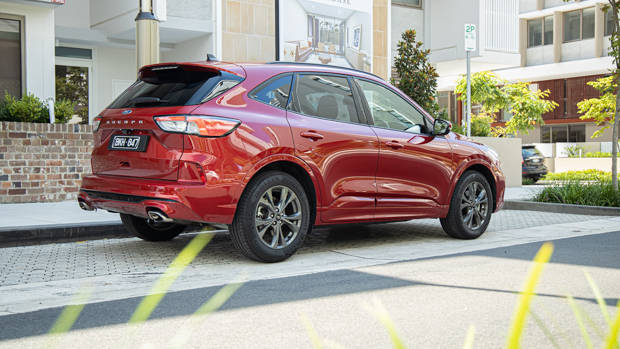
Every grade of the new Escape packs a powerful 183kW turbo petrol engine that outpunches nearly every rival – including the Toyota RAV4 Hybrid and Volkswagen Tiguan 162TSI.
Plenty of power is an appealing attribute – but it’s also a blunt instrument. How the rest of the Escape package comes together will be key to this medium-sized SUV’s success in Australia.
Ford have also offered some sharp deals to get the new Escape moving, with driveaway deals at $35,990 for a front-drive base model and $38,490 for the front-wheel-drive, sportily-suspended ST-Line we have on test.
In many ways, the Escape really is the Ford of medium SUVs.
Well, obviously – but what we mean by that is that the Escape drives in a way that is very familiar to those that have driven a Fiesta, Focus, Puma or Mondeo in recent years. In other words, it’s a product that Ford of Europe’s expert chassis engineers had their hands all over.
That’s a good thing, because the Escape is smooth, supple, controlled and athletic to drive. Like the best family Fords, it is comfortable enough for everyday school-run duties but it also offers up good steering and better handling than most rivals, meaning there’s also something here for keener drivers.
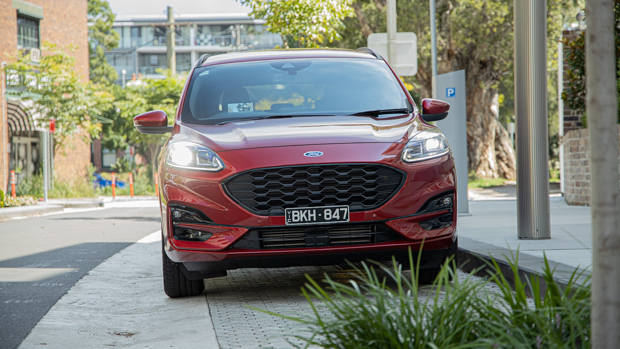
Ford Australia opted to reduce the complication of the Escape range compared to last time – no more so than in engine choice. What was once a vehicle that offered a choice of petrol and diesel engines in various sizes is now a one-choice affair.
The exclusive engine is a pretty powerful two-litre turbocharged petrol four-cylinder from Ford’s Ecoboost family of engines. Here, it makes 183kW of power and 387Nm of torque. That’s more than a Toyota RAV4 Hybrid (160kW) or a Mazda CX-5 turbo petrol (170kW).
Unlike the CX-5, which requires all-wheel-drive if you choose the most powerful engine, the Ford Escape allows a choice of cheaper front-wheel-drive, or for $3,000, you can option in AWD traction.
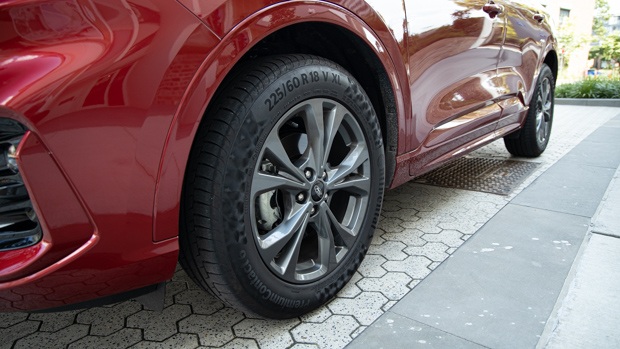
And you should, because the Escape has so much torque that it frequently spins the front wheels if you avoid paying for AWD. This leads to torque steer in the dry – where the steering wheel tugs under power – and plenty of wheelspin in the wet. We’d consider AWD essential: unfortunately, the affordable and well-specified $35,990 base model is front-wheel-drive only.
Torque is sent to the wheels via an eight-speed torque converter automatic transmission. The auto gets the job done – but it isn’t Ford’s finest gearbox. In our ST-Line test car, the transmission hunted for gears too often, while shifts lacked the crispness of Mazda’s six-speed auto, or even Volkswagen’s seven-speed dual clutch unit.
Later on this year, a plug-in hybrid (PHEV) variant will join the Escape range in ST-Line trim. The plug-in hybrid will produce 167kW of power combined, and will utilise a 14.4kWh battery for an all-electric range of 56km on the WLTP cycle.
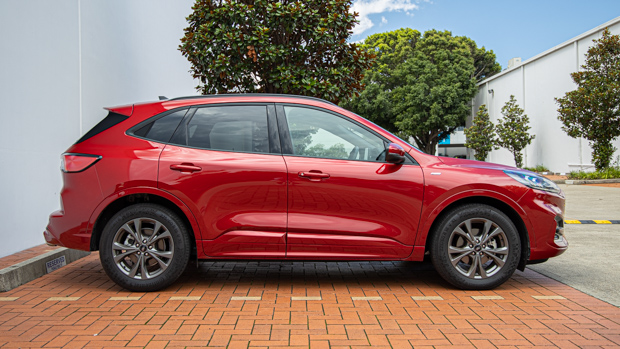
By contrast, the turbo petrol Escape ST-Line on test uses 8.6L/100km in either front-wheel-drive or AWD variations.
On the ride and handling front, Ford have struck the right balance with the Escape – especially in slightly sportier ST-Line guise.
There is a ‘comfort’ tune used for the base model, simply badged Escape, and the top-end and leather-lined Vignale, whereas the mid-range ST-Line has a sports suspension of its own.
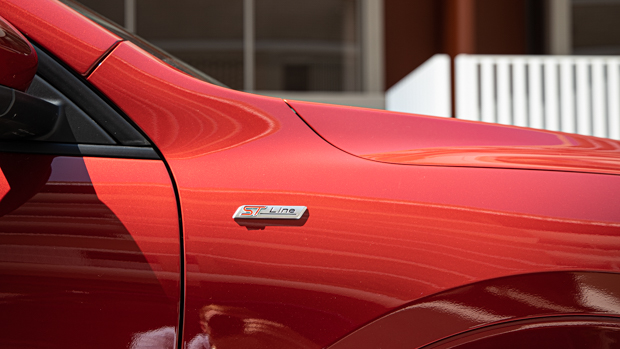
Even though the ST-Line is a bit stiffer than the other Escape variants, it strikes a pleasant balance of decent comfort in town with better body control than the base model or the Vignale. The way the ST-Line reins in body movements on a country road or, say, driving over a speed bump, proves this SUV to be supple but disciplined. The fact Ford has sensibly stuck to relatively chunky tyres and small-ish 18” alloy wheels helps the ride a lot.
That is a virtue that the Escape shares with its small car cousin – the highly-regarded Ford Focus. The pair share Ford’s modular C2 platform, which supports the rigid but well-composed dynamics that are common to both models.
The Escape takes a leaf out of the Focus’s handling playbook, at least in the steering department. This SUV has one of the best steering racks in its class, with crisp turn-in, a fairly quick ratio and the sort of intuitive connection through the wheel to the Continental ContiPremiumContact tyres that has you nodding along as a keen driver.
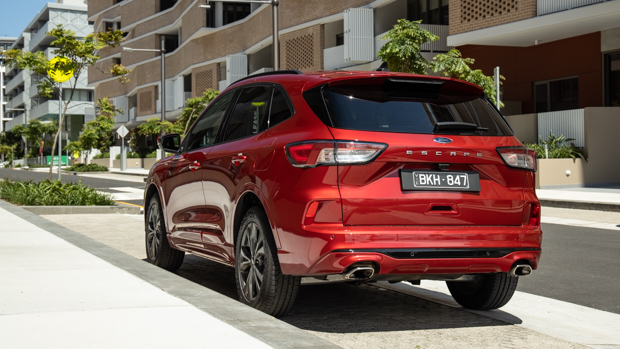
But as you start to pick up the pace on a flowing country road, you realise that Ford has throttled back the enjoyment you can have in an Escape to such a degree that it becomes a disappointment to drive quickly.
While the Escape’s chassis is more than capable of impressive handling, it is hobbled by an electronic stability control tune that is invasive, ham-fisted and sudden – everything the linear, smooth ESC calibration of a Skoda Kodiaq or Hyundai Tucson is not.
Just as you start to feel the Escape naturally moving around on a rural road, when cornering quickly but smoothly, the ESC jumps in and grabs harshly at individual brakes. There’s no way to dial down the sensitivity – not that you should need to.
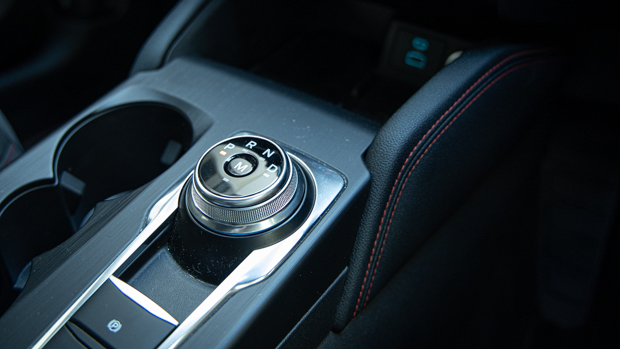
Of course, for most family buyers, quick cornering is not the goal of a medium SUV – but many Ford customers purchase blue-oval vehicles precisely because of the handling and extra layer of driver involvement this badge promises – so this was an opportunity missed.
On the safety front, all Escapes have the same level of equipment. There are six airbags, before the adaptive suite kicks off with forward autonomous emergency braking (AEB) that detects cars, pedestrians, and cyclists.
There is standard-fit adaptive cruise control with stop-and-go functionality, lane keeping assistance, blind spot monitoring, rear cross-traffic alert, and traffic sign recognition. Plus, you get automatic headlights and high beam, fatigue detection, tyre pressure monitoring, front and rear parking sensors and a reversing camera.
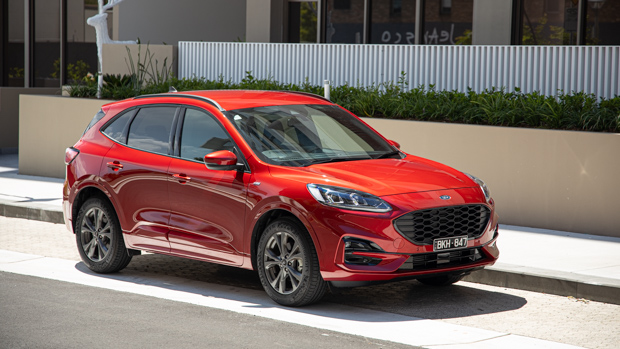
In our testing, we found the adaptive cruise control and lane keeping assistance to be well-tuned, with the Escape able to autonomously centre the vehicle in lane without bobbing from marking to marking.
The Ford Escape does not have reversing AEB that can help to avert a collision with a pedestrian or object behind the car.
The Ford Escape’s interior is functional and intelligently laid-out – but it isn’t especially exciting.
What the Ford offers instead is a practical cabin that has most things you need – and all the key functions are positioned logically. Smartly, Ford has retained knobs and buttons for the most important parts – volume, tuning, and the dual-zone climate control.
The aesthetic inside the Ford Escape is quite basic. This midsize SUV shares its interior design with virtually every other small and midsize Ford product – like the Puma small SUV, plus the Fiesta and Focus hatchbacks.
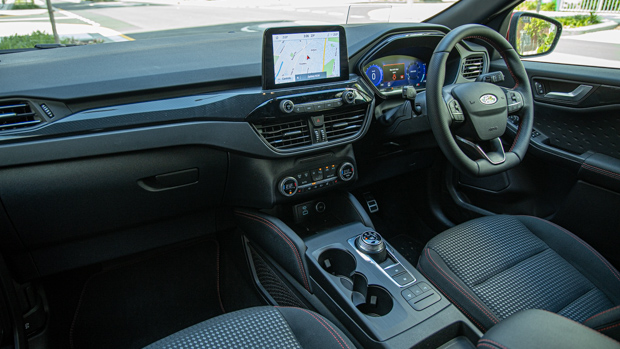
There’s a broad dashboard that integrates an eight-inch touchscreen on all grades. It’s a fairly crisp and snappy screen that runs Ford’s SYNC3 infotainment system that bundles wired Apple CarPlay and Android Auto with integrated satellite navigation, Bluetooth audio, DAB+ digital radio and the usual AM/FM bands.
Upgrading to the ST-Line doesn’t change much inside, though you do get alloy pedals, red stitching on the leather steering wheel and seats, and a 12.3” digital instrument cluster. But unlike in a Volkswagen Tiguan, you can’t put a map in front of the driver. In fact, the digital instruments look quite basic and flat – we’re not sure it’s much of a selling point.
The posh, top-end Vignale model gets a B&O Play ten-speaker premium stereo, but even the base car and ST-Line score a clear and bassy six-speaker system that is unbranded.
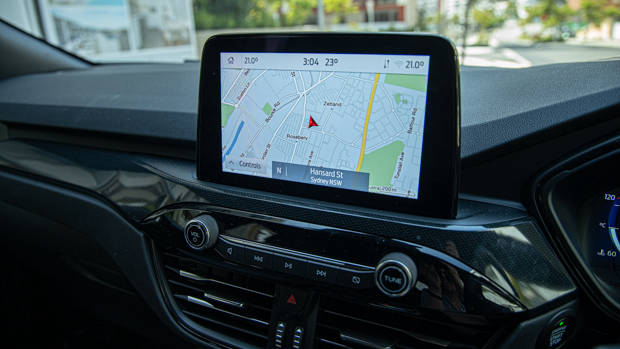
To be honest, the Escape ST-Line’s interior feels like a very European specification: there are plenty of features but it’s not fussy or luxurious. The seats are cloth and manually adjustable in eight ways, and there is rolling lumbar support. Unlike the all-grey base model, the ST-Line picks up red stitching on the pews and the leather steering wheel.
We’re not fans of how short the squab is on the front seats, though – drivers and passengers with long legs will feel unsupported over long drives.
Adding in the ST-Line Option Pack for $2,800 gives you very effective seat heating – not often seen on cloth upholstery – as well as a heated steering wheel, plus a head-up display and a power tailgate.
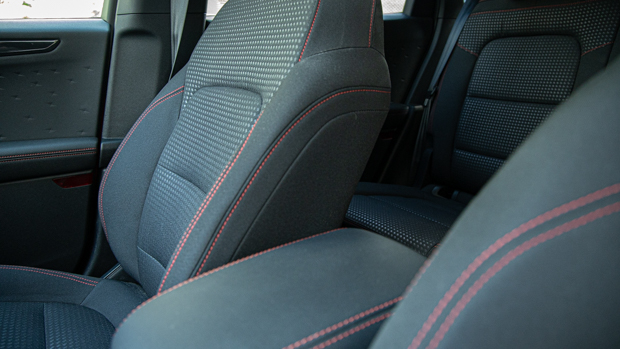
The step to the Escape Vignale costs $8,600 above the ST-Line, and that car adds in little luxuries like leather seats with power adjustment and memory for the driver, plus a panoramic sunroof. You also get big 20-inch wheels and quad-projector headlights outside.
But all Escapes, from the $35,990 base model up, include an integrated FordPass Connect modem and 4G data connection, allowing you to locate the car and control key functions from your phone. Plus, every grade has three USB ports and wireless device charging.
Material quality inside is generally good, with soft plastics used across the dashboard and front door surfaces. The soft and squidgy leather steering wheel also feels like it’s of relatively high quality.
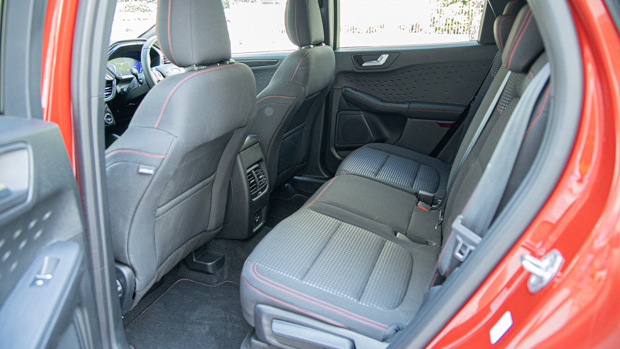
The back seats are considerably roomier than on the previous Escape: they now offer enough legroom and headroom to seat tall teenagers without a problem. The back row slides fore and aft to liberate more space for the boot – and in the back, air vents and USB ports are standard fit. Shame a rear armrest is only a feature of the flagship car.
Speaking of the Ford Escape’s boot, at 406 litres, it’s a reasonable size but far from the biggest in the class – a Tiguan offers up to 615 litres.
As standard, the Escape’s tailgate is manual, but the ST-Line Option Pack adds handy electric opening and closing.
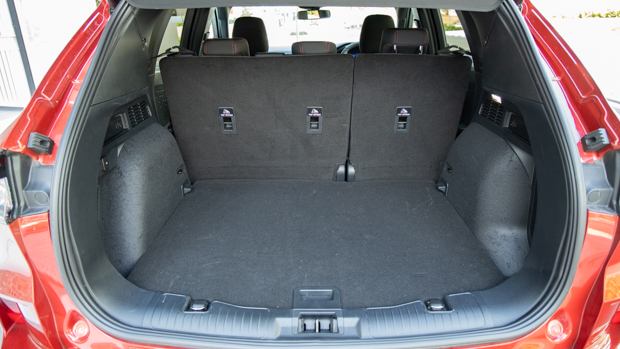
The Ford Escape is reasonably affordable to run.
The main area where it isn’t cheap is in terms of fuel costs. Until the Escape plug-in hybrid arrives, promising easy all-electric running around town, the sole turbo petrol engine option is quite thirsty on fuel.
Ford claims the Escape two-litre turbo uses 8.6L/100km, and on our test on town and country roads we observed about 9.5L/100km in the real world. It’s worth noting, though, that the Escape officially accepts the more affordable E10 petrol blend.
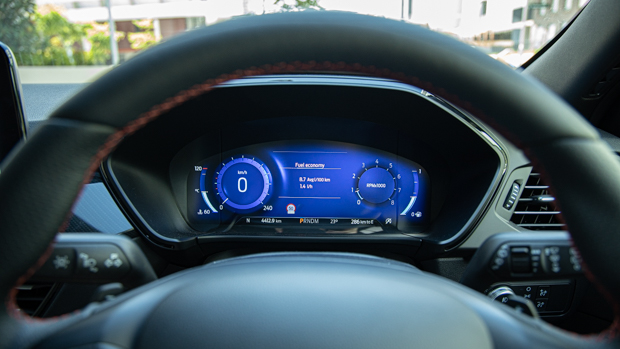
By contrast, the economy superstar of this segment – the Toyota RAV4 Hybrid – uses 6L/100km of fuel in the same real-world conditions.
Servicing the Ford Escape is done in 12 month or 15,000 kilometre intervals – whichever comes first. The cost of the first four visits (4 years / 60,000km) are capped at $299 per service. Most cars in this segment cap the fifth/75,00km service, but the Escape doesn’t.
Like other Fords, the Escape SUV is covered by this brand’s five year, unlimited kilometre warranty.
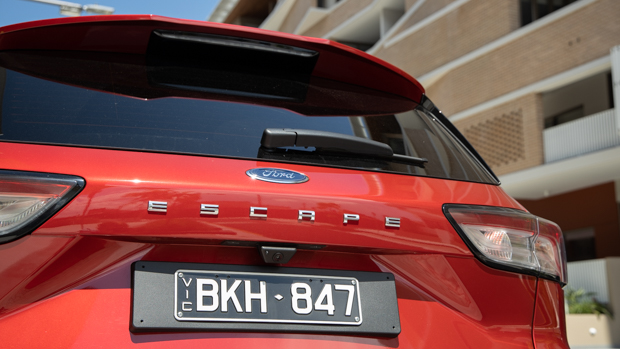
Ford provides a year of roadside assistance through your state auto club, with the membership being extended for up to seven years – renewable by servicing the Escape per the logbook requirements.
Other running cost benefits that are included in a new Escape are the provision of a free service loan car if available, satellite navigation updates, and price-match promises for brake and tyre replacements.
Like most Fords, the Escape’s x-factor should be its driver-focussed handling. This SUV packs crisp steering and a suspension that almost perfectly balances comfort and body control. But it’s let down by the tuning of some electronic systems which keep the driver at arm’s length.
What must be pointed out, though, is how effortlessly suited the Ford Escape’s powerful engine is to Australian country driving, even if we do think it should be paired with the optional all-wheel-drive system.
Certainly, the keenly-priced Escape offers an interesting alternative to the familiar set of midsize SUVs that are common sights on Australian roads.
The forthcoming Escape ST-Line PHEV will present one of the first plug-in electrified vehicles in the medium SUV category, and it may be worth waiting to test drive that car if you’re considering an Escape.
Variant tested ST-LINE (FWD)
Key specs (as tested)
About Chasing cars
Chasing Cars reviews are 100% independent.
Because we are powered by Budget Direct Insurance, we don’t receive advertising or sales revenue from car manufacturers.
We’re truly independent – giving you Australia’s best car reviews.
The estimate provided does not take into account your personal circumstances but is intended to give a general indication of the cost of insurance, in order to obtain a complete quote, please visit www.budgetdirect.com.au. Estimate includes 15%^ online discount.
^Conditions Apply
Budget Direct Insurance arranged by Auto & General Services Pty Ltd ACN 003 617 909(AGS) AFSL 241 411, for and on behalf of the insurer, Auto & General Insurance Company Limited(ABN 42 111 586 353, AFSL 285 571).Because we don’t know your financial needs, we can’t advise you if this insurance will suit you. You should consider your needs and the Product Disclosure Statement before making a decision to buy insurance. Terms and conditions apply.
Indicative quote based on assumptions including postcode , 40 year old male with no offences, licence suspensions or claims in the last 5 years, a NCD Rating 1 and no younger drivers listed. White car, driven up to 10,000kms a year, unfinanced, with no modifications, factory options and/or non-standard accessories, private use only and garaged at night.
^Online Discounts Terms & Conditions
1. Discounts apply to the premium paid for a new Budget Direct Gold Comprehensive Car Insurance, Third Party Property Only or Third Party Property, Fire & Theft Insurance policy initiated online on or after 29 March 2017. Discounts do not apply to optional Roadside Assistance.
2. Discounts do not apply to any renewal offer of insurance.
3. Discounts only apply to the insurance portion of the premium. Discounts are applied before government charges, taxes, levies and fees, including instalment processing fees (as applicable). The full extent of discounts may therefore be impacted.
4. We reserve the right to change the offer without notice.